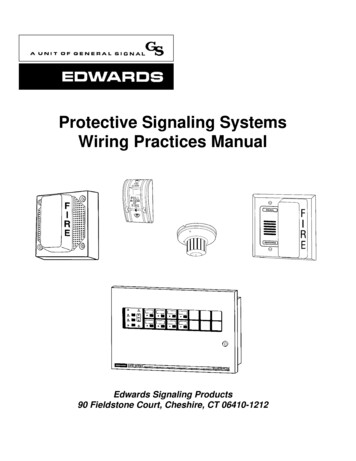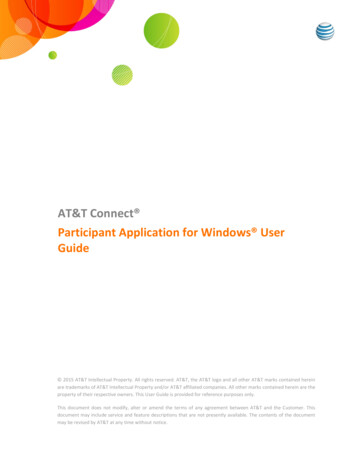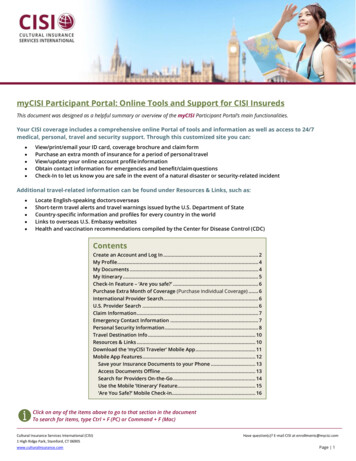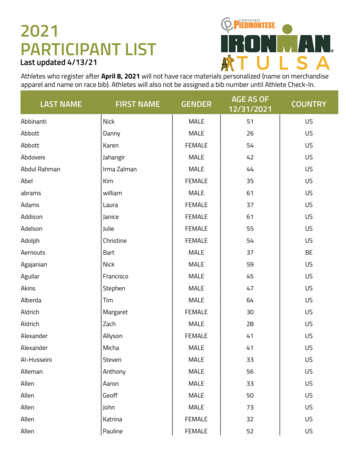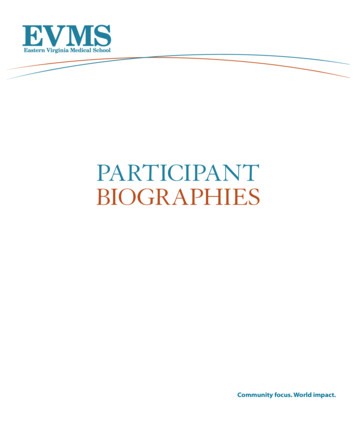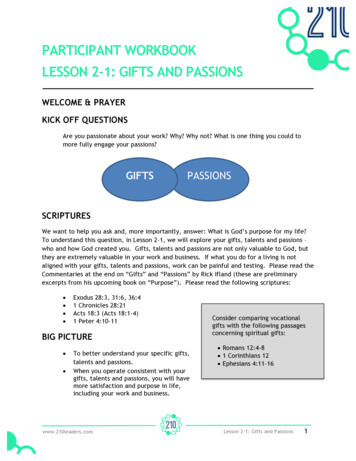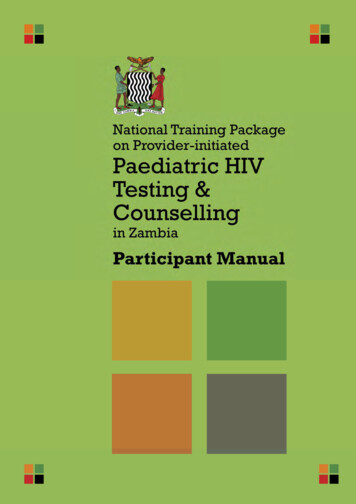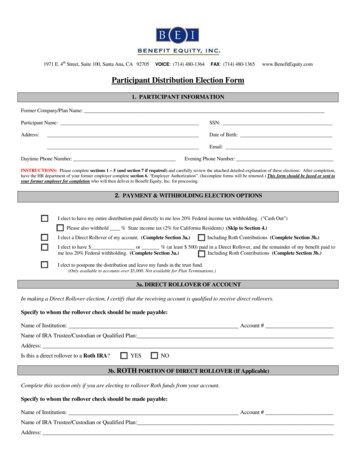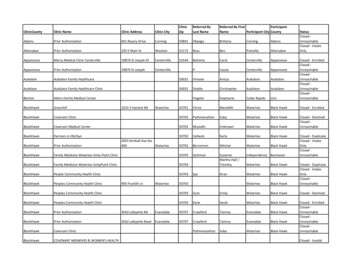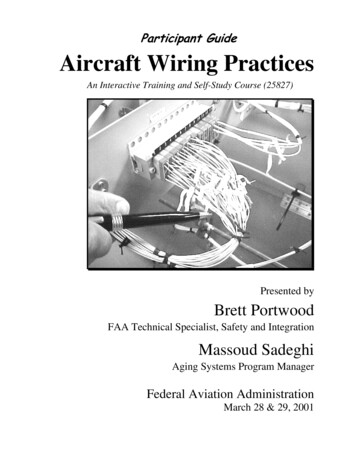
Transcription
Participant GuideAircraft Wiring PracticesAn Interactive Training and Self-Study Course (25827)Presented byBrett PortwoodFAA Technical Specialist, Safety and IntegrationMassoud SadeghiAging Systems Program ManagerFederal Aviation AdministrationMarch 28 & 29, 2001
Aircraft Wiring PracticesTable of ContentsINTRODUCTORY MATERIALSCourse Orientation .About This Course.Who Is the Target Audience?.Who Are the Instructors? .What Will You Learn? .How Will This Course Help You On-the-Job? .22221414Self-Assessment . 6Pre- & Post-Course Self-Assessment Questions. 6COURSE MATERIALSBackground .Introduction .Aging Systems Program.ASTRAC findings .Accident service history .1010111519Aging wiring overview. 25Introduction . 25Causes of wiring degradation. 26Current FAA guidance. 28Overview . 31Advisory Circular 43.13-1b .Topics to be addressed .Electrical load determination .Breaker and wire sizing/selection .Exercise 1: Circuit breaker size calculation.Figure 11-2 from 43.13-1b.Exercise 2: Wire size calculation .Figure 11-3 from 43.13-1b.Figure 11-4a from 43.13-1b .Figure 11-6 from 43.13-1b.Participant GuideVersion 1.0page ii31313133353942444546
Aircraft Wiring PracticesFigure 11-5 from 43.13-1b. 47Exercise 3: Wire harness current capacity . 50Routing, clamping, and bend radii . 53Exercise 4: Circuit breaker size calculation. 75Wire replacement and splicing . 81Wire terminals . 88Exercise 5: Terminal build up .102Grounding and bonding.103Wire marking.109Connectors and conduits .112Exercise 6: Pin arrangement.115Exercise 7: Bend radius.123Wire insulation properties .124AC 25-16 requirements .129Electrical fault and fire detection .129Circuit protection devices.130Wire separation.132Introduction .132Wire separation: 25.1309(b).133Wire separation: 25.903(d).135Wire separation: 25.1353(b).136Wire separation: 25.631 .137Post-TC wire separation .138Instructions for Continued Airworthiness .139General information/overview .139Cleaning requirements/practices .141Wiring general visual inspections (WGVI).142Non-destructive wire testing (NDT) methods.145Preemptive wire splice repair and/or wire replacement.145Wiring installation certification .149Introduction .149Wiring diagrams .150Actual wiring diagram.152Participant GuideVersion 1.0page iii
Aircraft Wiring PracticesWiring installation drawings .153Actual wire routing drawing .156Actual wiring installation and sub assemblies .157Actual wiring installation drawing parts list.158Questions and wrap-up .159Appendices.160AC 43.13-1b, Chapter 11AC 25-16Course Evaluation FormsParticipant GuideVersion 1.0page iv
Aircraft Wiring PracticesAircraft Wiring PracticesIntroductory MaterialsParticipant GuideVersion 1.0page 1
Aircraft Wiring PracticesCourse OrientationAbout ThisCourseAircraft Wiring Practices is designed to updateparticipants about a wide variety of wiring issues.Through the two-day (four hours per day) InteractiveTraining format, Brett Portwood, FAA TechnicalSpecialist, Safety and Integration, and Massoud Sadeghi,Aging Systems Program Manager, will provide you withthe basic concepts of Aircraft Wiring Practices, a coursethat provides an overview of the aging wiring history, anupdate on current FAA guidance, detailed information onAC 43.13-1b, AC 25-16, wire separation, andInstructions for Continued Airworthiness, and a reviewof what to look for on wiring diagrams and wiringinstallation drawings.Who Is theTargetAudience?This course is designed for new and experienced Systemsand Propulsion Transport Aircraft engineers who requireenough knowledge of wiring to be able to review datasubmitted by manufacturers.Who Are theInstructors?Brett Portwood is the FAA Technical Specialist forSafety and Integration. Brett has 11 years experiencewith the FAA in certification of transport avionicssystems, including fly-by-wire flight guidance systems,flight management systems, and electronic displays. As aTechnical Specialist, he provides expertise in safetyassessment methods and associated integration issues.Brett PortwoodParticipant GuideBrett is active in the FAA’s Aging System Program,ATSRAC, and wiring installation and maintenancepractices. He assisted with the investigation (aircraftwiring) of the MD-11 Swissair 111 accident. He workedwith Boeing to develop wiring practices workshops forFAA certification engineers and inspectors. Brett alsowas the FAA representative on the SAE S-18 SystemVersion 1.0page 2
Aircraft Wiring PracticesSafety Assessment commitee that authored ARP 4761,Guidelines and Methods of Conducting the SafetyAssessment Process on Civil Airborne Systems andEquipment.Prior to joining the FAA, Brett spent 12 years performingfault/failure analyses for industry and the Navy nuclearprogram.Mr. Portwood has a BS degree in Physics from SanDiego State University and has published professionalpapers on system safety assessment methods.Massoud SadeghiMassoud Sadeghi is the FAA Transport Aging SystemsProgram Manager responsible for implementingimprovements in the requirements of design, installation,mainenance, repair, and certification processes forairplane wiring. Massoud’s previous FAAresponsibilities include: SAE, ARAC, certification,validations, and policy and rulemaking in the areas ofelectrical systems, HIRF, and lightning.Prior to the FAA, Massoud’s industry experienceincluded Boeing Military Airplanes (Wichita), re-engine,upgrading electrical systems, and rewiring militaryairplanes (KC-135s); McDonnell Douglas, designing newelectrical systems for the new MD-90; and Boeing(Seattle), designing new electrical systems for the new777s. Before college, Massoud did electrical wiring ofcommercial and residential buildings.Mr. Sadeghi has taught college technical classes andcompany classes on Modern Aircraft Electrical Systems.He has both a BS and MS in Electrical Engineering fromthe University of Missouri-Columbia.Participant GuideVersion 1.0page 3
Aircraft Wiring PracticesWhat Will YouLearn?After completing this course you will be able to — Apply the concepts/aspects of aging wiring. Identify wiring factors used when approving wiringdiagrams. Identify the main purpose of reviewing wiringinstallation drawings and the wiring factors used whenapproving these installation drawings. Describe the requirements for Instructions forContinued Airworthiness as they relate to wiring.The purpose of this course is to deliver a detailedpresentation of all aspects of aging wiring. It coversapplicable 14 CFRs, policy, and industry practices in thearea of wiring. It will introduce primary factorsassociated with wire degradation. The course will alsoinclude TC/STC data package requirements, wireselection/protection, routing, clamping, splicing, andtermination practices, along with various examples,pictures, mockups, videos, etc. The course includeswiring maintenance concepts (e.g., cleans as you go),including how to perform a wiring general visualinspection.How Will ThisCourse HelpYou On-theJob?Given appropriate wiring materials to review forcertification, after completing this course you should beable to — Describe the major factors of wiring degradation andlist the characteristics of aging wiring. Identify and use the current FAA wiring regulationsand guidance. Determine if the circuit breakers, conductors, andconnectors are sized appropriately.Participant GuideVersion 1.0page 4
Aircraft Wiring Practices Determine if the type of wiring protection isappropriate for a given environment. Determine if the number and type of clamps, the feedthroughs/pass throughs, and conduits selected areappropriate. Evaluate the routing of the wire to ensure it has beendone in an optimum manner to prevent damage. Identify what wiring information has to be in theInstructions for Continued Airworthiness.Participant GuideVersion 1.0page 5
Aircraft Wiring e instructor will ask you at the begining of thepresentation to respond to the following questions aboutaircraft wiring practices.During the live broadcast, use the keypad to answerthese questions.1.What are the critical factors in addition to vibration that impactwiring degradation?a. Moisture, heat, improper installation.b. Improper installation, heat, length.c. Moisture, age, resistance.d. Heat, age, length.2.What is the minimum bend radius for unsupported wire?a. 3 times the largest diameter of the wire or cable in a bundle.b. 3 times the smallest diameter of the wire or cable in abundle.c. 10 times the largest diameter of the wire or cable in a bundle.d. 10 times the smallest diameter of the wire or cable in abundle.3.AC 25-16 is abouta. electrical load analysis.b. electrical fault and fire detection.c. wire routing.d. wire maintenance and repair.Participant GuideVersion 1.0page 6
Aircraft Wiring Practices4.What is the primary function of the circuit breaker in anaircraft?a. To remove power from aircraft systems.b. To protect aircraft equipment.c. To protect aircraft wiring.d. To protect electrical power sources.5.What is a key factor used in selecting wire?a. Marking method.b. Breaker size.c. Elasticity.d. Voltage drop.6.Wire current-carrying capacity decreases with altitude.a. True.b. False.7.What is the primary purpose of conduits?a. Facilitation of fluid drainage from wire bundles.b. Ease of wire routing.c. Protection of wire bundles against atmospheric pressure.d. Mechanical protection of wire
systems, including fly-by-wire flight guidance systems, flight management systems, and electronic displays. As a Technical Specialist, he provides expertise in safety assessment methods and associated integration issues. Brett is active in the FAA’s Aging System Program, ATSRAC, and wiring installation and maintenance practices. He assisted .
